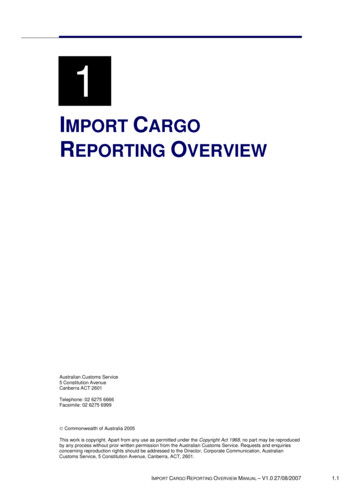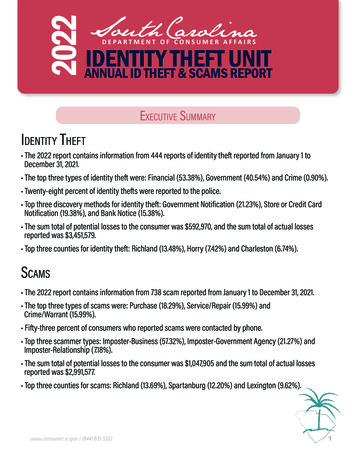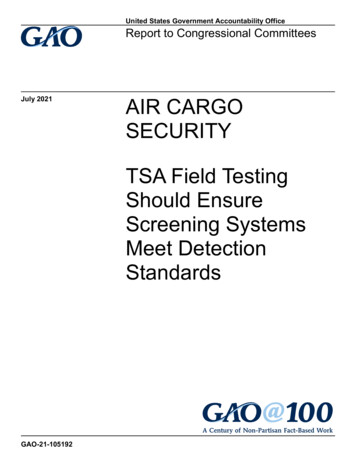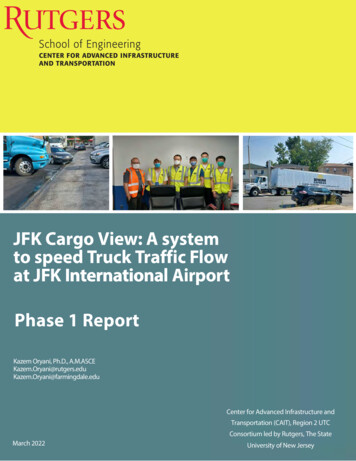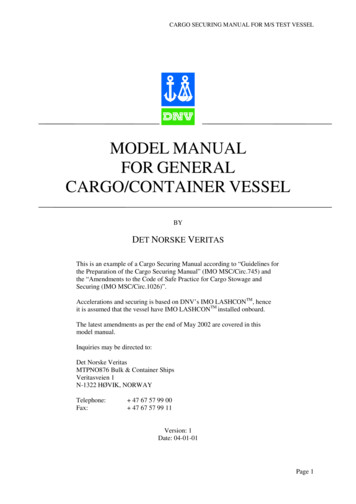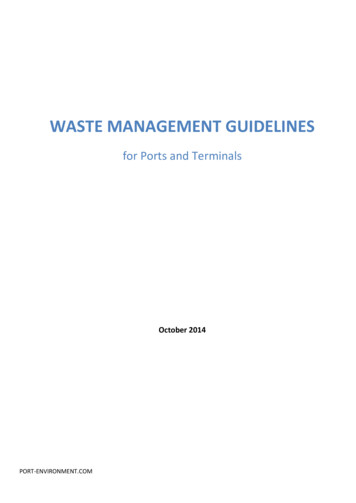
Transcription
2021 CargoTheft ReportTT CLUB,TAPA EMEAand BSI ConnectSCREEN Intelligence
TABLE OF CONTENTS01Introduction02Global Cargo Theft TrendsIncreased Idle Times and the Related Risks04Unpacking the Global Risk of Insider Theft in 202105Criminals Adopting Tactics to Target the ChangingEnvironment for Freight Transportation06Organizations Have Been Forced to Abruptly Adapt theirSupply Chains – What to know as this trend continues07Case study: Increase in railfreight thefts due to factorssuch as port congestion, is an increased weakness insupply chain security, as highlighted by this case in theLos Angeles areaBSI, TT Club, and TAPA EMEA - Cargo Theft Report 202103
INTRODUCTIONBSI publishes this report in coordination with TT Club and TAPA EMEA. BSI Supply Chain Services and Solutionsis the leading global supply chain intelligence provider, auditing services, audit & risk management compliancesolutions, and advisory services. BSI’s charter is to help corporations, governments, and associations identify,manage, and mitigate global supply chain risks and maintain world-class governance, risk, and complianceprograms. BSI’s holistic supply chain risk management suite is designed to predict and visualize risk and developrobust risk mitigation and compliance management programs to protect global supply chains, brands, andreputation. BSI’s intelligence-infused supply chain solutions and global network empower the clients to understandglobal supply chain risk with unequaled precision.BSI, TT Club, and TAPA EMEA - Cargo Theft Report 2021TT Club is the established market-leading independent provider of mutual insurance and related risk managementservices to the international transport and logistics industry. The Club’s services include specialist underwriting,claims management, and risk and loss management advice, supported by a global office network. TT Club’sprimary objective is to help make the industry safer and more secure. Established in 1968, TT Club has more than1100 Members, spanning owners and operators, ports and terminals, and logistics companies, working acrossmaritime, road, rail, and air. Members range from some of the world’s largest logistics operators to smaller, bespokecompanies managing similar risks. The Club is renowned for its high-quality service, in-depth industry knowledge,and enduring Member loyalty. It retains more than 97% of its Members with a third of its entire membership havingchosen to insure with the Club for 20 years or more. TT Club is managed by Thomas Miller - an independent andinternational provider of insurance, professional, and investment services.The Transported Asset Protection Association (TAPA) is a not-for-profit industry that helps Manufacturers/Shippersand Logistics Service Providers minimise losses resulting from cargo thefts and to increase the security andresilience of their supply chains. Today, in the Europe, Middle East & Africa (EMEA) region, the Association providesa host of certifiable, independently-audited industry Standards for facilities, trucking operations and secureparking as well as training. The TAPA EMEA Intelligence System (TIS) also provide the latest and historic recordedincident intelligence, enabling more secure route planning by helping members understand when, where and howcriminals are targeting supply chains, and the products most frequently stolen. The Association strongly advocatesthe reporting of all cargo thefts to increase industry knowledge of risks and to assist companies’ loss preventionstrategies. TAPA EMEA’s President and CEO is Thorsten Neumann. TAPA EMEA has contributed to the Europe,Middle East & Africa content of this report.1
GLOBAL CARGO THEFT TRENDS A strong increase in idle times due to significant port congestion throughout the year The emerging risks of insider theft The vulnerabilities that come with increased use of digital means by suppliers Consequences of an urgent need to change the locations of suppliers, and what to keep in mind during thatprocess Lastly, in a case study, we unpack how cargo thefts from railway locations and trains has shown to be anincreased weakness in supply chains, particularly in the region of Los Angeles in the United States.BSI, TT Club, and TAPA EMEA - Cargo Theft Report 2021Throughout 2021, global supply chains continued to face significant security, continuity, and resiliency threatsdue to the COVID-19 pandemic, and although its impact seems to lessen in the early stages of 2022, it causeddisruptions and major delays throughout 2021, and still has massive residual impacts globally. Many of theconcerns BSI, TT Club, and TAPA EMEA monitored throughout 2021 set the tone for continued risk to supply chainsecurity in 2022, but simultaneously new challenges and risks are likely to play a large role, such as the ongoingconflict in Ukraine which is disrupting many industries on the short-term, and could have a variety of long-termeffects. This report seeks to highlight the cargo security threats that plagued supply chains in 2021 and provideorganizations with mitigation techniques to combat these threats, and considers some of the emerging risks weanticipate in the upcoming months and years. BSI, TT Club, and TAPA EMEA have identified five key themes thatstood out as we looked back on 2021:As we look ahead, we provide mitigation recommendations throughout the report for the themes we will dive into.2
Global Theft Trends 2021BSI, TT Club, and TAPA EMEA - Cargo Theft Report 2021Based on recent incident data via collaboration and partnerships with law enforcement, government, non-government, commercial partners,trade associations, open-source media reports, and input from BSI advisors and expert consultants3
Global Theft Trends 2020 vs 2021BSI, TT Club, and TAPA EMEA - Cargo Theft Report 2021Based on recent incident data via collaboration and partnerships with law enforcement, government, non-government, commercial partners,trade associations, open-source media reports, and input from BSI advisors and expert consultants4
A STRONG INCREASE IN IDLE TIMESLED TO AN INCREASE IN CARGOTARGETED AT RESTWhile actual global cargo theft incident numbers are down from 2020, in 2021, we saw a significant increase incriminals targeting cargo at rest. Whether it be at unsecured parking lots or container yards near port facilities,delays indirectly made cargo more vulnerable to tampering by thieves and smugglers. These cargo crime trendsare juxtaposed with record-breaking cargo transiting through ports, driving record-breaking port congestion andidle times. These supply chain trends are furthermore symptomatic of macro-economic trends of a ‘push and pull’market. Various issues emerged indirectly from this port congestion, relative to region and risk profiles. However,in this report, we will focus on cargo theft, stowaway introduction, and business continuity risks as seen in someAfrican and South American countries.BSI, TT Club, and TAPA EMEA - Cargo Theft Report 2021Port Congestion in North America Linked toDiversification of Theft Types and Increase in RailThefts, Latin America Impacted EconomicallyGlobal logistics hubs are facing a double risk with both the port congestion and spike in demand leading to traincars and cargo containers sitting idle for extended periods of time, thereby making them more vulnerable totheft. In North America, with the backlog of trains crisscrossing from the West Coast to the East Coast, trainsare subsequently left parked for extended periods of time, leading to spikes in rail thefts across the UnitedStates, notably in key logistics hubs connected to local ports, like East Los Angeles in California, and in Memphis,Tennessee. This is especially the case across the United States for high-value and shortage-prone goods likeelectronics.5
The record level of port congestion is also leading to the diversification of theft types, in 2021, as port congestion reacheda record high average wait time of 17 days, containers continued to pile up at ports, leading to a variety of new cargo thefttrends, particularly the diversification of theft types. For example, as warehouses are getting pushed to capacity, pivotallogistics players, like drivers, are forced to diversify where cargo is going, from secured lots at facilities, to drop lots, andeventually to unsecured parking lots due to the overflow.This diversification of locations is similarly reflected in the diversification of theft types and locations in the United States.These cargo crime trend changes can in part be due to congestion and delays. And as Truck drivers are increasingly forcedto park their trucks with the tractor/trailer/container in unsecured parking lots or outside of delivery sites due to the fullsecured lots, this will likely be a sustained trend parallel to the diversification of routes and modalities for logistical playersdue in part to the congestion.BSI, TT Club, and TAPA EMEA - Cargo Theft Report 2021Meanwhile, across Latin America, especially Mexico, Colombia, Brazil, Peru, and Panama, port congestion, combined withhigher shipping premiums, led to fewer exports from these countries, so less cargo transiting through them in 2021.Cargo Theft and Stowaway Introduction TrendsRelative to Idle Times in EuropeIn Europe, continuing high levels of cargo thefts and stowaway introduction were two issues closely linked to the pressurescreated by increased congestion and longer idle times.BSI, TT Club and TAPA EMEA have previously noted the growing number of thefts from facilities and, most notably, fromtrucks loaded with cargo and parked outside of facilities, since the beginning of the COVID-19 pandemic in 2020. In theseincidents, employees of warehouses and facilities load cargo onto trucks before leaving them parked outside with minimalsecurity overnight. When a truck driver arrives the next morning, they report that the cargo has been stolen.Periodically throughout 2021 and 2020, areas near the Port of Calais in northern France experienced congestion due tochanging rules and requirements for crossing the border to the United Kingdom. Migrants often waited along highwaysor rest areas and parking lots in the area hoping for an opportunity to stowaway onto the trucks waiting in these queuesto cross the English Channel. In December 2021, regional authorities closed parking lots and rest areas in the Nortkerquearea of Calais due to this inherent risk.6
Rising Shipping Costs and Congestion DrivingShortages Over New Cargo Theft TrendsDue to a reduction in shipping capacity, a premium on ocean freight, and long idle times at ports in the globalnorth, African ports experienced a general reduction in ships making calls in 2021. Some countries, such asNamibia, Angola, Kenya, and Guinea, lost direct connections to foreign ports. These patterns of global trade,that favor countries in the global north, resulted in reductions to manufacturing capacity and shortages in somefactories in African nations that depend on imports through the continent’s ports.Strict COVID-19 Containment Policies DisruptShipping in AsiaBSI, TT Club, and TAPA EMEA - Cargo Theft Report 2021Strict COVID-19 restrictions contributed to reduced operational capacity in the shipping industry in 2021, especiallyin Hong Kong and China, where zero-COVID mitigation policies, including mandatory testing and lengthy quarantineperiods, led to labor shortages that consequently increased the waiting times for ships awaiting port entry at portsin the Pearl River Delta. According to reports, an average of 13 ships per day awaited entry into Asian ports inDecember 2021. In January 2022, this number of ships increased to 22.5 per day.As recently as March 2022, reports indicate that rising numbers of COVID-19 infections in Hong Kong, especiallyamong truckers transiting between Hong Kong and mainland China, are significantly reducing local truckingcapacity. Trucking capacity between Hong Kong and the mainland has reportedly experienced a 70 percentreduction. Hong Kong is reporting over 50,000 new cases per day, meaning that disruptions stemming fromreduced trucking capacity are likely to continue through the beginning of the next quarter.7
UNPACKING THE GLOBAL RISKOF INSIDER THEFT IN 2021 ANDONWARDSBSI, TT Club, and TAPA EMEA - Cargo Theft Report 2021Criminal organizations increasingly infiltrate supply chains or manageto bribe warehouse workers or truck drivers to steal cargo. Insidertheft participation typically occurs when either warehouse or facilityemployees disclose confidential information pertaining to shippingand delivery times, or when employees intentionally leave doors andgates unlocked or ajar overnight, granting criminals easier access tocarry out thefts. Another common tactic used during insider theftinvolves criminals bribing or coercing truck drivers to divert fromtheir assigned delivery routes. During these route diversions, thetruck operator will stop at facilities or designated locations alongthe road where criminals will unload partial loads of goods from thevehicle before the driver returns to their original delivery route.Globally, the products most frequently involved in insider theftsin 2021 included agriculture (14 percent), food and beverage (12percent), construction materials (10 percent), electronics (10 percent),and metal (nine percent). Notably, many of the materials used toproduce these various goods, such as nitrogen, iron ore, lumber,steel, and semiconductors among others, have all experienced sharpprice increases since the outbreak of the global pandemic.Moreover, the price of crude oil has increased to levels not seen since2009 and 2011, reaching about 109 a barrel, at the time of thiswriting. This spike in the price of global crude oil has contributed to the increase in the overall cost to transportgoods, as cargo trucks run on diesel fuel. The ongoing conflict between Ukraine and Russia is likely to exacerbateglobal fuel prices, especially if other countries follow the United States’ decision to ban Russian oil imports.A combination of general price hikes for goods, increasing costs to transport those goods, the ongoing threatfrom COVID-19 and the conflict in Ukraine will further disrupt global supply chains in 2022 and could create anenvironment more conducive to insider theft.Identifying Global Areas of Concern for InsiderTheftAccording to BSI, TT Club and TAPA EMEA data collected throughout 2021, approximately 20 percent of all theftincidents reported in Europe involved some form of insider participation. Of these incidents involving insiders,approximately 56 percent occurred in warehouses, followed by 19 percent in production facilities. The top Europeancountries of concern for thefts involving insider participation in 2021 were Russia and Italy; these thefts typicallyincluded elements of either supply chain corruption or organized crime.The top countries of concern in Asia for insider theft in 2021 included India, Indonesia, China, Vietnam, andBangladesh. In Asia, insider thefts accounted for 13 percent of all thefts in 2021. 37 percent of those insider theftincidents involved goods stolen from warehouses, and 18 percent of insider thefts involved goods stolen fromproduction facilities.8
Thefts involving insider participation are a growing concern in Bangladesh, where thefts along the DhakaChittagong highway have significantly increased over the past year, according to several local reports andcorroborated by BSI, TT Club and TAPA EMEA data. Members of highway robbery gangs are reportedly increasinglygaining employment as drivers for textile exporters to assist in the diversion and theft of goods that are en route tothe Chittagong Port for exportation. In many cases, exporters do not become aware of the theft until they receivecomplaints from buyers detailing how some of the products were missing upon delivery.In North America, reported incidents of insider-related theft in Mexico and the United States significantlyoutnumbered Canada. Roughly 5.2 percent of recorded theft incidents involved insider participation in NorthAmerica in 2021. While this is relatively low when compared to Europe and Asia, the trend is on the increase from2019 and 2020. In fact, since 2020, the risk of insider participation has increased by 48 percent, from 1.7 percentin 2020 to 5.2 percent in 2021, and the majority of the incidents are concentrated in Mexico and the United States.Historically, various countries in South America are susceptible to insider participation, including Brazil, Argentina,Colombia, and Peru. In South America, there was a slight increase in the risk of insider participation in recordedcargo theft incidents between 2020 and 2021, with the majority occurring in Brazil, Argentina, Peru, and Chile.BSI, TT Club, and TAPA EMEA - Cargo Theft Report 2021Industries at the greatest risk across both North and South America remain agriculture and prepared products,industrial and manufacturing, the pharmaceutical industry, petroleum and minerals, and consumer products andmass merchandising.In the Middle East and Africa, evidence indicates that insider participation remained prevalent in 2021 and willlikely linger in 2022 in the Gulf countries, especially the United Arab Emirates (UAE) and the Kingdom of SaudiArabia (KSA). In these countries, criminals primarily target facilities to steal high-value products such as electronics.Despite government efforts to combat the issue, supply chain corruption remains a problem in the KSA and UAE,likely exacerbating trends of insider participation.The KSA and UAE are also home to large free trade zones that form a structural part of the countries’ economies.In these free trade zones, large volumes of cargo transit for import and re-export. This environment is conduciveto smuggling schemes, while the large volume of trade coupled with supply chain corruption heightens cargovulnerabilities. For instance, BSI has recorded incidents of security company employees in Saudi Arabia whoreportedly conspired to steal from a vehicle in their charge, in addition to multiple instances in the United ArabEmirates of cargo thefts committed by employees and drivers.9
Recommendations for Mitigating Riskof Insider TheftsBSI, TT Club and TAPA EMEA recommend auditing cargo storage companies for stringent employee backgroundchecks and basic physical security measures, including CCTV surveillance. Installing GPS tracking on vehicles usedin the transportation of goods will help in mitigating the potential for the diversion of goods along their deliveryroutes.Threat awareness training, incentives for reporting security incidents, and ensuring that employees that leave thecompany have forfeited all property used to access facilities can also help mitigate the threat of insider theft.Insider Participation Thefts a Growing Concernfor Supply Chains in 2022BSI, TT Club, and TAPA EMEA - Cargo Theft Report 2021Cargo thefts involving insider participation continue to be a concern for global supply chains in 2022, especiallywith aggravating factors such as the global COVID-19 pandemic, rising cost of living, and the recent developmentsbetween Ukraine and Russia, which all have the potential to further exacerbate poor economic conditions, creatingmore incentives for insider corruption and cargo thefts generally.10
CRIMINALS ADOPT NEW TACTICSTO TARGET THE CHANGINGENVIRONMENT FOR FREIGHTTRANSPORTATIONCriminals have adopted new tactics to target the changing environment for freight transportation. The growingreliance on technology and a rapidly changing market for sourcing materials and components have increasedreliability and effectiveness, but also opened up new avenues of opportunity for criminals to take advantage ofcompanies’ increased vulnerabilities.BSI, TT Club, and TAPA EMEA - Cargo Theft Report 2021Some new tactics identified in the past year include the increased targeting of freight transportation serviceexchange apps and websites. These freight service applications, which have already been taken advantage of inrecent years by criminals operating in South America and Brazil specifically, involve companies posting listings fortruck drivers to respond to help move goods. By utilizing these applications that require significantly less vettingthan other methods, criminals are more easily able to present themselves as legitimate carriers. Throughout2021, transporters in Europe began reporting a rise in fictitious pickups and fraudulent carriers, highlighting theexpansion of this risk worldwide.Fraudulent Theft Top Locations Globally IncludeBrazil, Russia, Italy, and MexicoThe top locations worldwide reporting fraudulent thefts, including route diversions and fictitious pickups, includeBrazil, Russia, Italy, and Mexico. In such cases, thieves falsely present themselves as legitimate carriers, most oftento steal food and beverage, and agricultural-type products. However, data from 2021 and 2022 so far appears toshow a growing number of thefts of metals and construction supplies stolen via this method.In Europe, thieves presenting themselves as legitimate carriers do not appear to target one specific commoditytype over another; however, most products stolen generally follow global trends which show greater thefts of foodand beverage, agriculture, automotive, and construction materials, as well as clothing and footwear, cosmetics andother high-demand consumer goods. While Russia showed over a four percent increase in the number of fraudulentthefts conducted, it is in Italy where the greatest percentage shift occurred. Although BSI, TT Club and TAPA EMEAdid not record a single incident of fraudulent theft in Italy in 2020, in 2021 around ten percent of all fraudulentthefts globally occurred in Italy.These thefts generally involve carriers picking up goods without arousing suspicion, and the theft often isn’teven discovered until the legitimate delivery carrier arrives to pick up the goods. Oftentimes, this occurs whencompanies hire new or unknown transport companies and fail to conduct adequate due diligence checks beforehanding over goods. The subsequently diverted goods are often sent to eastern European countries for resale.Thefts involving technology access do not always occur during pickups or at facilities. They often occur in transitor anywhere en route. In the United States, for example, our joint data noted that in the second half of 2021,criminals increasingly targeted pharmacies and products in unsecured parking lots. These types of thefts canvary in sophistication, with thieves going so far as to illegally access secure computer systems to steal identitiesand fraudulently represent themselves to unknowing companies. Reports worldwide also suggest that corruptemployees may inform criminals about shipment times and lanes, thus allowing them to target certain trucks andsteal high-value goods.11
The “rollover” theft tactic, prominent in the United Kingdom, involves thieves being aware of shipment times and locationsfor certain transportations to conduct thefts. They may obtain this information from corrupt employees or by managingto access technology regarding truck locations and ulitization; and although companies generally have strict protocolsin place for trucks departing their facilities, security may drop once the truck is in transit. In this tactic, thieves will evensurround a moving truck with cars to allow one gang member to jump onto the truck to open the doors and throw thegoods into the other cars. Oftentimes, such thefts are not realized until the delivery is made and items are recorded asmissing.Governments ModifyLaws to Tackle TheseEvolved ThreatsBSI, TT Club, and TAPA EMEA - Cargo Theft Report 2021The issue of fraud conducted via freight exchanges anddigital marketplaces has grown to the point where theFrench government has modified legislation to regulatethese avenues through which companies and transporterscan connect. Simultaneously, the United States haswarned the Federal Trade Commission will track downcompanies that had not yet worked to resolve issuesassociated with cybersecurity risks, more specifically theLog4j vulnerability.Known as the Mobility Orientation Law (LOM), the recentupdate to the French legislation reportedly goes beyonddefining both marketplaces and participants by requiringthose who are active on the platforms to verify theirlegitimacy through registration and communicationrequirements. The legislation now appears to holdparticipants, who engage in contractual services throughthese electronic marketplaces, responsible for a rangeof potential issues that could occur during the executionof the service, such as damage or loss of goods or thearrival of goods outside the designated timeframe. Thislegislation highlights how the focus is no longer only onthe accessibility and usefulness of these types of onlinefreight transportation service exchange sites, but alsoon the inherent risk that comes with communicating andultimately conducting business with parties via the internet.The United States’ government is also beginning to take a stronger stance on cybersecurity within the private sector. InAugust 2021, the Senate voted to dedicate over 1.9 billion U.S. dollars to growing cybersecurity defenses in the 1 trillioninfrastructure bill. These funds will be used to better secure critical infrastructure, provide money to a federal cyberoffice, and support organizations vulnerable to attacks. This funding included designating 1 billion to help state and localgovernments deter attacks and protect data and information, 100 million to increase the government’s capabilities torespond to network attacks, and 21 million to support the new National Cyber Director.Furthermore, on December 14, cybersecurity experts announced the discovery of Log4j vulnerability in a registry libraryused by many U.S.-based companies. Experts referred to this vulnerability as “the most critical seen this year” andrecommended updating systems immediately. On January 4, 2022, the Federal Trade Commission warned that it wouldtrack down companies that had not yet worked to resolve the Log4j vulnerability, thus holding businesses accountable forapproving their cybersecurity.12
Criminals in Russia Utilizing a Variety ofTechnologies to Conduct Thefts – Case StudyCargo thefts in Russia frequently involve fraudulent means, both on the part of opportunistic employees andsophisticated, organized operations targeting high-value shipments.In one incident, an individual registered a logistics company and completed multiple small-value cargo transportoperations with third-party vehicles to build an appearance of credibility. Upon securing a multi-million transportoperation for shampoo and lotion products, the individual instructed the third-party vehicle to deliver the goods toan incorrect location in an attempt to steal the shipment.BSI, TT Club, and TAPA EMEA - Cargo Theft Report 2021In another incident, experts warned that Russian-speaking criminal groups had expanded a scam to infiltrateonline logistics platforms in Europe and the United States. The criminal groups operated the scam by advertisinglow-cost transportation services on logistics platforms. The thieves then moved the potential victim from theplatform to a third-party messenger application to access bank card information, potentially utilizing stolen webpages from legitimate courier services. Sources report that there may be 40 such gangs conducting this scam, bothwithin Russia and abroad in countries such as Romania, France, Poland, the United States, and multiple CentralAsian republics.Recommendations from BSI’s Practice Director for Security andResilience, Tony Pelli for mitigating these risksTo mitigate this risk, companies can take several actions, such as: Work to verify the trucking company - call the phone number they have listed, visit the website, and check tomake sure the number they are using is not for a company that recently went out of business Where possible, set up pre-alerts - i.e. ask for the driver’s name, trailer number, and license plate number inadvance and have appointment times for each pickup Check driver IDs and record information about drivers - check to make sure their ID is not expired and matchesthe actual driver Train people in the dispatch/shipping office to recognize suspicious behavior - if the driver looks suspicious,shows up far too early, is wearing sunglasses/hoodie/etc. inside, something is probably wrong Make sure all carriers undertake employee background screening, including criminal history checks wherepossible Install cameras near dispatch/shipping/receiving windows to capture images of the driver’s face for later ID ifsomething goes wrong Take pictures/copies of IDs if that’s allowed13
ORGANIZATIONS HAVE BEEN FORCEDTO ABRUPTLY ADAPT THE SUPPLYCHAIN SINCE THE START OF THEPANDEMICIn recent years, many organizations have made drastic changes to their supply chain. Global events, such as theCOVID-19 pandemic and truck driver shortages, have led organizations to utilize new workflow processes, inaddition to new routes and transportation methods that differ strongly from what they had been doing routinely foryears prior.BSI, TT Club, and TAPA EMEA - Cargo Theft Report 2021In many cases, organizations have not successfully completed proper due diligence before making theseadjustments to secure their modified supply chains. In addition, staff shortages in a variety of industries haveincreased simultaneously, meaning many employees who are responsible for securing or transporting goods areoperating without sufficient training, or suppliers are dependent on temporary staff members.Changing Sourcing Locations Requires Thoroughand Ongoing Risk AssessmentsCOVID-19 had an immense impact on organizations, requiring new business plans and workflow processes. Thesedisruptions, in many cases, forced organizations to
supply chain security, as highlighted by this case in the Los Angeles area . BSI, TT lub, and TAP ME argo Theft Report 2021 1 INTRODUCTION BSI publishes this report in coordination with TT Club and TAPA EMEA. BSI Supply Chain Services and Solutions . parking as well as training. The TAPA EMEA Intelligence System (TIS) also provide the latest .
